Home >> House of Worship >> Holidays
Rosh Hashanah
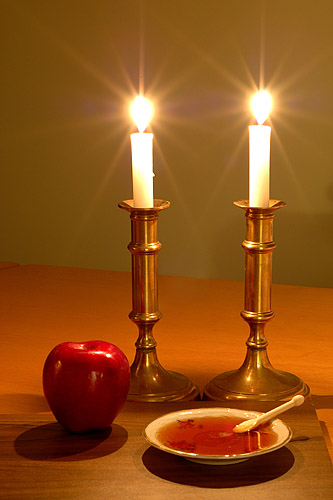 Rosh Hashanah (literally, "Head of the Year") refers to the celebration of the Jewish New Year. The holiday is observed on the first day of the Hebrew month of Tishrei, which usually falls in September or October, and marks the beginning of a ten-day period of prayer, self-examination and repentance, which culminate on the fast day of Yom Kippur. These ten days are referred to as Yamim Noraim, the Days of Awe or the High Holy Days. Rosh Hashanah (literally, "Head of the Year") refers to the celebration of the Jewish New Year. The holiday is observed on the first day of the Hebrew month of Tishrei, which usually falls in September or October, and marks the beginning of a ten-day period of prayer, self-examination and repentance, which culminate on the fast day of Yom Kippur. These ten days are referred to as Yamim Noraim, the Days of Awe or the High Holy Days.
While there are elements of joy and celebration, Rosh Hashanah is a deeply religious occasion. The customs and symbols of Rosh Hashanah reflect the holiday's dual emphasis, happiness and humility. Special customs observed on Rosh Hashanah include; the sounding of the shofar, using round challahs, eating apples and honey (and other sweet foods) for a sweet new year.
S’lichot is a customary service observed before Rosh HaShanah. S'lichot, meaning forgiveness, refers to the penitential prayers recited by Jews prior to the onset of the High Holiday season. It is a solemn and fitting preparation for ten days of reflection and self-examination.
Click Here for more High Holy Day Resources.
|
Yom Kippur
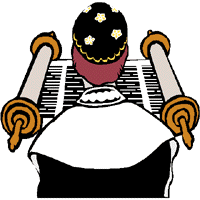
Yom Kippur is the "Day of Atonement" and refers to the annual Jewish observance of fasting, prayer and repentance. This is considered to be the holiest day in the Jewish calendar. In three separate passages in the Torah, the Jewish people are told, "the tenth day of the seventh month is the Day of Atonement. It shall be a sacred occasion for you: You shall practice self-denial."(Leviticus 23:27). Fasting is seen as fulfilling this biblical commandment. The Yom Kippur fast also enables us to put aside our physical desires and to concentrate on our spiritual needs through prayer, repentance and self improvement. It is customary in the days before Yom Kippur for Jews to seek out friends and family whom they have wronged and personally ask for their forgiveness.
Click Here for more High Holiday Resources |
Sukkot

Sukkot, a Hebrew word meaning "booths" or "huts,” refers to the Jewish festival of giving thanks for the fall harvest as well as the commemoration of the forty years of Jewish wandering in the desert after Sinai.
Sukkot is celebrated five days after Yom Kippur on the 15th of Tishrei, and is marked by several distinct traditions. One tradition, which takes the commandment to "dwell in booths" literally, is to build a sukkah, a booth or hut. A sukkah is often erected by Jews during this festival, and it is common practice for some to eat and even live in these temporary dwellings during Sukkot.
Click Here to learn more about Sukkot. |
Simchat Torah |
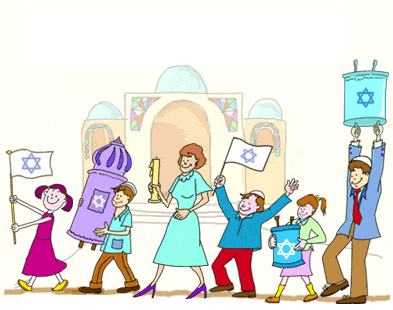
Simchat Torah, Hebrew for "rejoicing in the Law", celebrates the completion of the annual reading of the Torah. Simchat Torah is a joyous festival, in which we affirm our view of the Torah as a tree of life and demonstrate a living example of never-ending, lifelong study. Torah scrolls are taken from the ark and carried or danced around the synagogue seven times. During the Torah service, the concluding section of Deuteronomy is read, and immediately following, the opening section of Genesis, or B'reishit as it is called in Hebrew, is read.
Chanukah
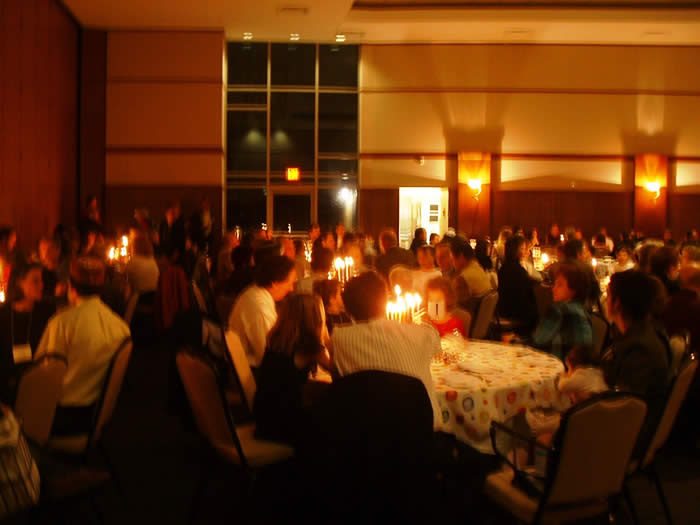
Chanukah, meaning "dedication" in Hebrew refers to the joyous eight-day celebration during which Jews commemorate the victory of the Macabees over the armies of Syria in 165 B.C. E. and the subsequent liberation and "rededication" of the Temple in Jerusalem.
The modern home celebration of Chanukah centers around the lighting of the chanukiah, a special menorah for Chanukah and unique foods, latkes and jelly doughnuts; and special songs and games.
Chanukah Resources |
Tu BiSh'vat
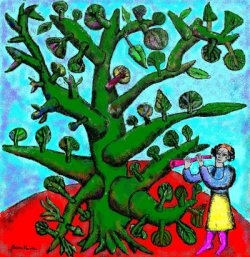 Tu BiSh'vat or the "New Year of the Trees" is Jewish Arbor Day. The holiday is observed on the fifteenth (tu) of Sh'vat. Scholars believe that Tu BiSh'vat was originally an agricultural festival, marking the emergence of spring. Tu BiSh'vat or the "New Year of the Trees" is Jewish Arbor Day. The holiday is observed on the fifteenth (tu) of Sh'vat. Scholars believe that Tu BiSh'vat was originally an agricultural festival, marking the emergence of spring.
After the destruction of the Temple in 70 A.C.E. this holiday was a way for Jews to symbolically bind themselves to their former homeland by eating foods that could be found in Israel. In the sixteenth and seventeenth century Kabbalists created a ritual for Tu BiSh'vat similar to the Passover Seder.
Today, Tu BiSh'vat has also become a tree planting festival in Israel, in which both Israelis and Jews around the world plant trees in honor or in memory of a loved one or friend.
|
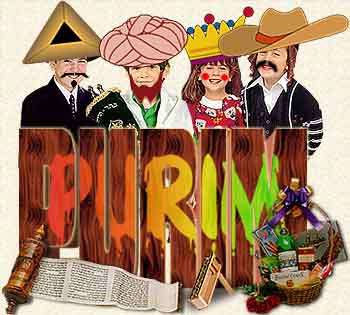
Purim is celebrated by the reading of the Scroll of Esther, known in Hebrew as the Megillat Esther, which relates the basic 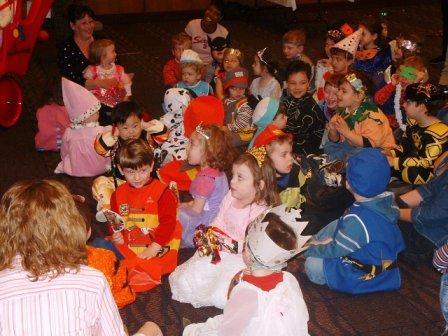 story of Purim. Under the rule of King Ahashuerus, Haman, the King's prime minister, plots to exterminate all of the Jews of Persia. His plan is foiled by Queen Esther and her uncle Mordechai, who ultimately save the Jews of the land from destruction. The reading of the Megillah is typically a rowdy affair, which is punctuated by booing and noisemaking when Haman's name is read aloud. story of Purim. Under the rule of King Ahashuerus, Haman, the King's prime minister, plots to exterminate all of the Jews of Persia. His plan is foiled by Queen Esther and her uncle Mordechai, who ultimately save the Jews of the land from destruction. The reading of the Megillah is typically a rowdy affair, which is punctuated by booing and noisemaking when Haman's name is read aloud.
Purim is an unusual holiday in many respects. First, Esther is the only Book of the Bible in which God is not mentioned. Second, Purim, like Cha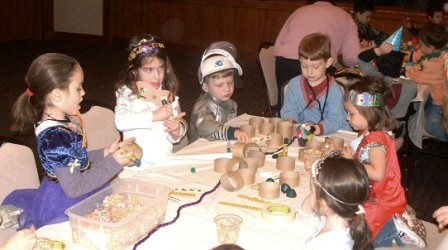 nukah, is viewed by tradition as a minor festival. The elevation of Purim to a major holiday was a result of the Jewish historical experience. Over the centuries, Haman became the embodiment of every anti-Semite in every land where Jews were oppressed. The significance in Purim lies not so much in how it began, but in what it has become-a thankful and joyous affirmation of Jewish survival against all odds. nukah, is viewed by tradition as a minor festival. The elevation of Purim to a major holiday was a result of the Jewish historical experience. Over the centuries, Haman became the embodiment of every anti-Semite in every land where Jews were oppressed. The significance in Purim lies not so much in how it began, but in what it has become-a thankful and joyous affirmation of Jewish survival against all odds.
|
Pesach
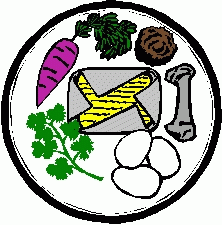
Pesach, known as Passover in English, is a major Jewish spring festival, commemorating the Exodus from Egypt over 3,000 years ago. The ritual observance of this holiday centers around a special home service called the Seder (meaning "order") and a festive meal. During Pesach eating chametz (leaven bread) is forbidden, thus we eat matzah unleavened bread). On the eve of the fifteenth day of Nisan in the Hebrew calendar, we read from a book called the Hagaddah, meaning "telling," which contains the order of prayers, rituals, readings and songs for the Pesach Seder. The Pesach Seder is the only ritual meal in the Jewish calendar year for which such an order is prescribed, hence its name.
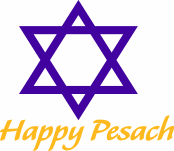
The Seder has a number of scriptural bases. Exodus 12:3-11 describes the meal of lamb, unleavened bread, and bitter herbs which the Israelites ate just prior to the Exodus. In addition, three separate passages in Exodus (12:26-7, 13:8, 13:14) and one in Deuteronomy (6:20-21) enunciate the duty of the parents to tell the story of the Exodus to their children. The Seder plate contains various symbolic foods referred to in the Seder itself.
Click Here for additional information about Pesach. |
Shavuot
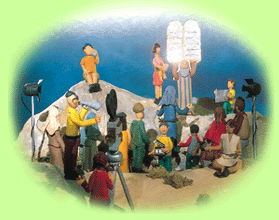 Shavuot is a Hebrew word meaning "weeks" and refers to the Jewish festival marking the giving of the Torah at Mount Sinai. Shavuot, like so many other Jewish holidays began as an ancient agricultural festival, marking the end of the spring barley harvest and the beginning of the summer wheat harvest. Shavuot was distinguished in ancient times by bringing crop offerings to the Temple in Jerusalem. Shavuot is a Hebrew word meaning "weeks" and refers to the Jewish festival marking the giving of the Torah at Mount Sinai. Shavuot, like so many other Jewish holidays began as an ancient agricultural festival, marking the end of the spring barley harvest and the beginning of the summer wheat harvest. Shavuot was distinguished in ancient times by bringing crop offerings to the Temple in Jerusalem.
Shavuot, also known as the Festival of the Giving of the Torah, dates from biblical times, and helps to explain the holiday's name, "Weeks." The Torah tells us it took precisely forty-nine days for our ancestors to travel from Egypt to the foot of Mount Sinai (the same number of days as the Counting of the Omer) where they were to receive the Torah. Thus, Leviticus 23:21 commands: "And you shall proclaim that day (the fiftieth day) to be a holy convocation?" The name Shavuot, "Weeks," then symbolizes the completion of a seven-week journey.
Special customs on Shavuot are the reading of the Book of Ruth, which reminds us that we too can find a continual source of blessing in our tradition. Another tradition includes staying up all night to study Torah and Mishnah, a custom called Tikkun Leil Shavuot, which symbolizes our commitment to the Torah, and that we are always ready and awake to receive the Torah. Traditionally, dairy dishes are served on this holiday to symbolize the sweetness of the Torah, as well as the "land of milk and honey."
|
Tishah B'Av
Tishah B'Av, which means the "Ninth of Av", refers to a traditional day of mourning the destruction of both ancient Temples in Jerusalem. In contrast to Orthodoxy, Reform Judaism has never assigned a central religious role to the ancient Temple. Therefore, mourning the destruction of the Temple in such an elaborate fashion did not seem meaningful.
More recently, in Reform Judaism Tishah B'Av has been transformed into a day to remember many Jewish tragedies that have occurred throughout history.
|
Yom HaZikaron
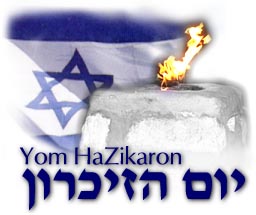
Yom HaZikaron is Israel’s Memorial day, observed for the soldiers who were killed in defense of the State of Israel from the War of Independence (1948) through present day. It takes place on the 4th of Iyar (in the spring) and is observed with civil, military and religious ceremonies throughout Israel.
Oftentimes, memorial candles are lit and flags at schools, camps and synagogues are flown at half-mast.
Current Israel Features and Resources
|
Yom HaShoah
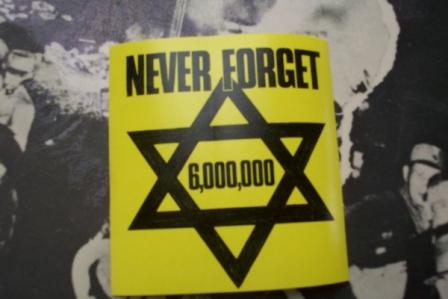
Yom HaShoah, also known as Holocaust Remembrance Day, occurs on the 27th of Nissan. "Shoah," which means catastrophe or utter destruction in Hebrew, refers to the atrocities that were committed against the Jewish people during World War II. This is a memorial day for those who died in the Shoah.
|
Yom Ha'atzma-ut
Yom Ha'atzma-ut, Israeli Independence Day, marks the establishment of the modern state of Israel in 1948. It is observed on the 5th of Iyar in the Hebrew calendar, which usually falls in April.
|
Lag Ba'Omer
An omer refers to an ancient Hebrew measure of grain, amounting to about 3.6 liters. Biblic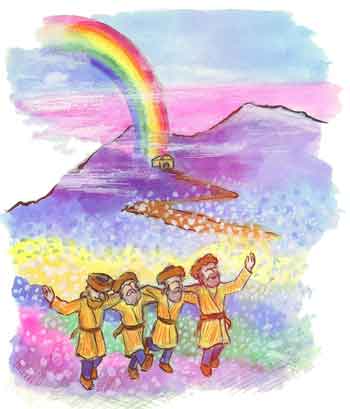 al law forbade any use of the new barley crop until an omer was brought as an offering to the Temple in Jerusalem. The Book of Leviticus (23:15-16) also commanded: "And from the day on which you bring the offering…you shall count off seven weeks. They must be complete." This commandment led to the practice of the Sefirat Ha'omer, or the forty-nine days of the "Counting of the Omer". The omer is counted from the second day of Passover and ends on Shavuot. al law forbade any use of the new barley crop until an omer was brought as an offering to the Temple in Jerusalem. The Book of Leviticus (23:15-16) also commanded: "And from the day on which you bring the offering…you shall count off seven weeks. They must be complete." This commandment led to the practice of the Sefirat Ha'omer, or the forty-nine days of the "Counting of the Omer". The omer is counted from the second day of Passover and ends on Shavuot.
Lag Ba'Omer is the shorthand way of saying the thirty-third day of the omer. It is celebrated to commemorate the day a plague ended in which thousands of students of Rabbi Akiba, a Talmudic scholar, died during the Counting of the Omer. The period of counting is traditionally observed as a period of mourning. The mourning, however, is set aside on Lag Ba'Omer, making it day of special joy and festivity.
|
Shavuot
 Shavuot is a Hebrew word meaning "weeks" and refers to the Jewish festival marking the giving of the Torah at Mount Sinai. Shavuot, like so many other Jewish holidays began as an ancient agricultural festival, marking the end of the spring barley harvest and the beginning of the summer wheat harvest. Shavuot was distinguished in ancient times by bringing crop offerings to the Temple in Jerusalem. Shavuot is a Hebrew word meaning "weeks" and refers to the Jewish festival marking the giving of the Torah at Mount Sinai. Shavuot, like so many other Jewish holidays began as an ancient agricultural festival, marking the end of the spring barley harvest and the beginning of the summer wheat harvest. Shavuot was distinguished in ancient times by bringing crop offerings to the Temple in Jerusalem.
Shavuot, also known as the Festival of the Giving of the Torah, dates from biblical times, and helps to explain the holiday's name, "Weeks." The Torah tells us it took precisely forty-nine days for our ancestors to travel from Egypt to the foot of Mount Sinai (the same number of days as the Counting of the Omer) where they were to receive the Torah. Thus, Leviticus 23:21 commands: "And you shall proclaim that day (the fiftieth day) to be a holy convocation?" The name Shavuot, "Weeks," then symbolizes the completion of a seven-week journey.
Special customs on Shavuot are the reading of the Book of Ruth, which reminds us that we too can find a continual source of blessing in our tradition. Another tradition includes staying up all night to study Torah and Mishnah, a custom called Tikkun Leil Shavuot, which symbolizes our commitment to the Torah, and that we are always ready and awake to receive the Torah. Traditionally, dairy dishes are served on this holiday to symbolize the sweetness of the Torah, as well as the "land of milk and honey."
|
Tishah B'Av
Tishah B'Av, which means the "Ninth of Av", refers to a traditional day of mourning the destruction of both ancient Temples in Jerusalem. In contrast to Orthodoxy, Reform Judaism has never assigned a central religious role to the ancient Temple. Therefore, mourning the destruction of the Temple in such an elaborate fashion did not seem meaningful.
More recently, in Reform Judaism Tishah B'Av has been transformed into a day to remember many Jewish tragedies that have occurred throughout history.
|
Click Here for a current calendar of the Jewish Holidays.
Contact Us
|

|

 Rosh Hashanah (literally, "Head of the Year") refers to the celebration of the Jewish New Year. The holiday is observed on the first day of the Hebrew month of Tishrei, which usually falls in September or October, and marks the beginning of a ten-day period of prayer, self-examination and repentance, which culminate on the fast day of Yom Kippur. These ten days are referred to as Yamim Noraim, the Days of Awe or the High Holy Days.
Rosh Hashanah (literally, "Head of the Year") refers to the celebration of the Jewish New Year. The holiday is observed on the first day of the Hebrew month of Tishrei, which usually falls in September or October, and marks the beginning of a ten-day period of prayer, self-examination and repentance, which culminate on the fast day of Yom Kippur. These ten days are referred to as Yamim Noraim, the Days of Awe or the High Holy Days. 

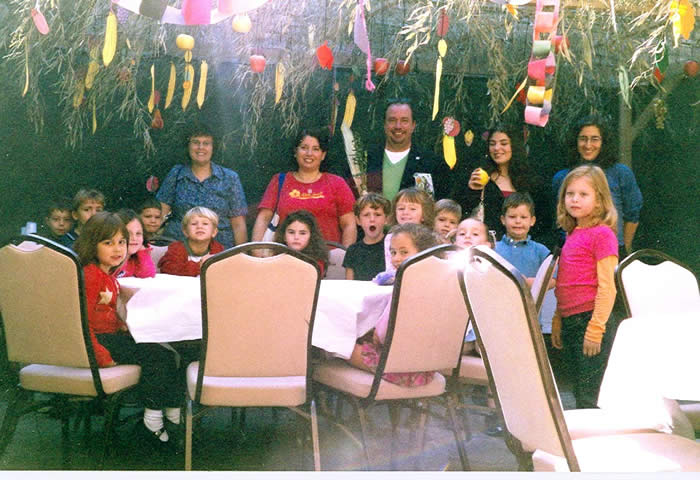
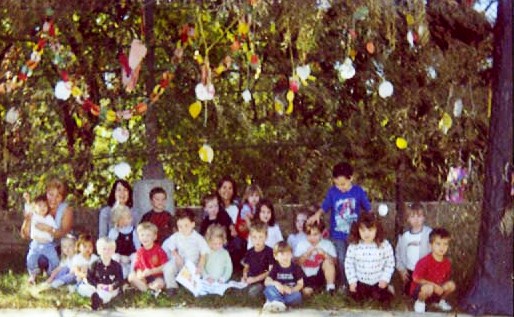



 Tu BiSh'vat or the "New Year of the Trees" is Jewish Arbor Day. The holiday is observed on the fifteenth (tu) of Sh'vat. Scholars believe that Tu BiSh'vat was originally an agricultural festival, marking the emergence of spring.
Tu BiSh'vat or the "New Year of the Trees" is Jewish Arbor Day. The holiday is observed on the fifteenth (tu) of Sh'vat. Scholars believe that Tu BiSh'vat was originally an agricultural festival, marking the emergence of spring.
 story of Purim. Under the rule of King Ahashuerus, Haman, the King's prime minister, plots to exterminate all of the Jews of Persia. His plan is foiled by Queen Esther and her uncle Mordechai, who ultimately save the Jews of the land from destruction. The reading of the Megillah is typically a rowdy affair, which is punctuated by booing and noisemaking when Haman's name is read aloud.
story of Purim. Under the rule of King Ahashuerus, Haman, the King's prime minister, plots to exterminate all of the Jews of Persia. His plan is foiled by Queen Esther and her uncle Mordechai, who ultimately save the Jews of the land from destruction. The reading of the Megillah is typically a rowdy affair, which is punctuated by booing and noisemaking when Haman's name is read aloud.  nukah, is viewed by tradition as a minor festival. The elevation of Purim to a major holiday was a result of the Jewish historical experience. Over the centuries, Haman became the embodiment of every anti-Semite in every land where Jews were oppressed. The significance in Purim lies not so much in how it began, but in what it has become-a thankful and joyous affirmation of Jewish survival against all odds.
nukah, is viewed by tradition as a minor festival. The elevation of Purim to a major holiday was a result of the Jewish historical experience. Over the centuries, Haman became the embodiment of every anti-Semite in every land where Jews were oppressed. The significance in Purim lies not so much in how it began, but in what it has become-a thankful and joyous affirmation of Jewish survival against all odds. 

 Shavuot is a Hebrew word meaning "weeks" and refers to the Jewish festival marking the giving of the Torah at Mount Sinai. Shavuot, like so many other Jewish holidays began as an ancient agricultural festival, marking the end of the spring barley harvest and the beginning of the summer wheat harvest. Shavuot was distinguished in ancient times by bringing crop offerings to the Temple in Jerusalem.
Shavuot is a Hebrew word meaning "weeks" and refers to the Jewish festival marking the giving of the Torah at Mount Sinai. Shavuot, like so many other Jewish holidays began as an ancient agricultural festival, marking the end of the spring barley harvest and the beginning of the summer wheat harvest. Shavuot was distinguished in ancient times by bringing crop offerings to the Temple in Jerusalem. 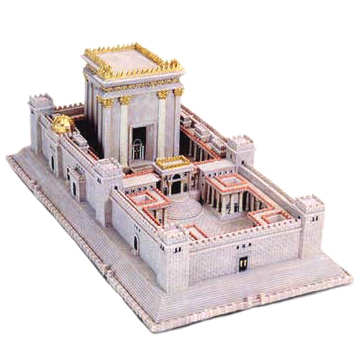


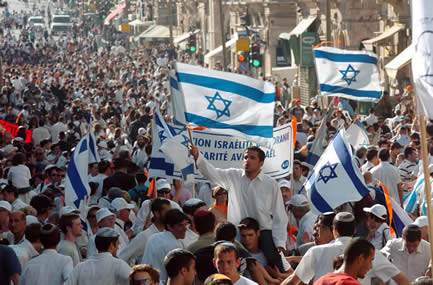
 al law forbade any use of the new barley crop until an omer was brought as an offering to the Temple in Jerusalem. The Book of Leviticus (23:15-16) also commanded: "And from the day on which you bring the offering…you shall count off seven weeks. They must be complete." This commandment led to the practice of the Sefirat Ha'omer, or the forty-nine days of the "Counting of the Omer". The omer is counted from the second day of Passover and ends on Shavuot.
al law forbade any use of the new barley crop until an omer was brought as an offering to the Temple in Jerusalem. The Book of Leviticus (23:15-16) also commanded: "And from the day on which you bring the offering…you shall count off seven weeks. They must be complete." This commandment led to the practice of the Sefirat Ha'omer, or the forty-nine days of the "Counting of the Omer". The omer is counted from the second day of Passover and ends on Shavuot.